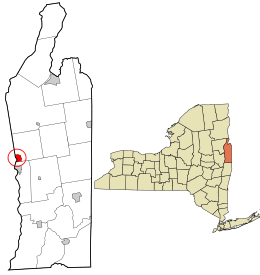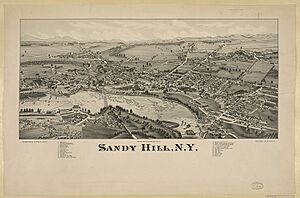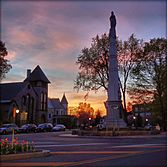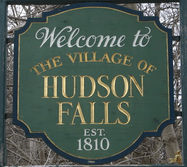Hudson Falls, New York facts for kids
Quick facts for kids
Hudson Falls
|
|
|---|---|

Buildings in Hudson Falls, July 2014
|
|

Location in Washington County and the state of New York.
|
|
| Country | United States |
| State | New York |
| County | Washington |
| Incorporated | 1810 as Sandy Hill, 1910 as Hudson Falls |
| Area | |
| • Total | 1.92 sq mi (4.97 km2) |
| • Land | 1.86 sq mi (4.82 km2) |
| • Water | 0.06 sq mi (0.15 km2) |
| Elevation | 295 ft (90 m) |
| Population
(2020)
|
|
| • Total | 7,428 |
| • Density | 3,990.87/sq mi (1,540.49/km2) |
| Time zone | UTC-5 (Eastern (EST)) |
| • Summer (DST) | UTC-4 (EDT) |
| ZIP code |
12839
|
| Area code(s) | 518 |
| FIPS code | 36-35980 |
| GNIS feature ID | 0974163 |
Hudson Falls is a small village in Washington County, New York, United States. It's located in the southwest part of the town of Kingsbury. You can find it right on U.S. Route 4.
Hudson Falls is part of the larger Glens Falls Metropolitan Statistical Area. In 2020, about 7,428 people lived there. For a long time, until 1994, Hudson Falls was the main government center, or county seat, for Washington County. The county seat then moved to Fort Edward.
Contents
Discovering the History of Hudson Falls
Hudson Falls has a rich past, starting as a small settlement and growing into a busy village. It was once known by a different name: Sandy Hill.
Early Beginnings and the Name Sandy Hill
The story of Hudson Falls began in 1764. That year, a man named Albert Baker built the first sawmill in the Kingsbury area. This mill was near a place now called Baker's Falls. By 1792, people were already calling this area "Sandy Hill."
In 1810, Sandy Hill officially became a village. It kept the name Sandy Hill. Over the next few decades, the village grew. Its borders expanded to their current size in the 1840s.
How Canals Helped Hudson Falls Grow
Around 1824, an important waterway was built. It was called the Glens Falls Feeder Canal. This canal brought water from the Hudson River to the Champlain Canal. With the new canal, Sandy Hill became a busy place for making things. Factories produced lumber, paper, pianos, wagons, and other goods.
Today, the Glens Falls Feeder Canal is no longer used for boats. Instead, it's a beautiful park that is fourteen miles long. You can walk or bike along the old path where horses used to pull canal boats.
Famous Buildings Made with Local Stone
Stone from quarries in Hudson Falls was used to build some very famous structures. This stone helped create the Bennington Battle Monument in 1889. It was also used for the amazing Brooklyn Bridge! The old quarry site is now used by a school organization called the Washington-Saratoga-Warren-Hamilton-Essex Board of Cooperative Educational Services.
The Union Bag and Paper Company's Impact
In 1851, Francis Wolle invented the first machine to make paper bags. His company later became the Union Bag and Paper Company. In 1892, this company moved its paper mill to Hudson Falls.
In 1906, the Union Paper and Bag Company built the Fenimore Bridge, also known as the Sandy Hill Bridge. This bridge crossed the Hudson River, connecting Hudson Falls in Washington County with Moreau in Saratoga County. At the time, it was the longest concrete arch bridge in the world with multiple spans. The bridge was closed in 1989. There have been ideas to reopen it, like turning it into a path for walking and biking.
From Sandy Hill to Hudson Falls
In 1910, the village's name officially changed from Sandy Hill to Hudson Falls. Several important places in Hudson Falls are listed on the National Register of Historic Places. These include the Glens Falls Feeder Canal, the Hudson Falls Historic District, and the United States Post Office.
Places of Worship in Hudson Falls
Hudson Falls has a history of different churches that have served its community for many years.
- The First Presbyterian Church of Hudson Falls started in 1803. Their first church building was dedicated in 1827. A larger church was built in its place and dedicated in 1895.
- Zion Episcopal Church was founded in 1817. Their first building was completed in 1849. In 1968, a fire damaged the inside, but it was rebuilt.
- St. Mary's was the first Roman Catholic church in the area, built in the 1830s. After it burned down, a new one was built. St. Paul's Church was founded in the 1870s for French Canadians. After their church burned down in 1974, the two parishes joined together as the Church of St. Mary's/St. Paul's.
Famous People from Hudson Falls
Many notable individuals have connections to Hudson Falls.
- William Bronk managed a lumber business in Hudson Falls. He was a poet and writer who won the National Book Award in 1982.
- Townsend Harris, the first United States consul-general to Japan, was born in Hudson Falls.
- Henry C. Martindale was a lawyer and a member of the United States House of Representatives.
- Tony DeSare is a jazz singer, pianist, and songwriter.
- Governor Nathaniel Pitcher lived in Sandy Hill.
- Roger Skinner was a member of the New York State Senate and a judge.
Geography and Location
Hudson Falls is located on the east bank of the Hudson River. This river forms the western border of Washington County. The village has a total area of about 1.9 square miles (4.9 square kilometers). Most of this area is land, with a small amount of water.
In the middle of the main business area, there is a nice open space called a village green. Major roads like NY Route 196 (Maple Street) and NY Route 254 (River Street) meet US Route 4 in Hudson Falls.
Population and Demographics
The population of Hudson Falls has changed over the years. Here's a look at how many people have lived there:
| Historical population | |||
|---|---|---|---|
| Census | Pop. | %± | |
| 1870 | 2,347 | — | |
| 1880 | 2,487 | 6.0% | |
| 1890 | 2,895 | 16.4% | |
| 1900 | 4,473 | 54.5% | |
| 1910 | 5,189 | 16.0% | |
| 1920 | 5,761 | 11.0% | |
| 1930 | 6,449 | 11.9% | |
| 1940 | 6,654 | 3.2% | |
| 1950 | 7,236 | 8.7% | |
| 1960 | 7,752 | 7.1% | |
| 1970 | 7,917 | 2.1% | |
| 1980 | 7,419 | −6.3% | |
| 1990 | 7,651 | 3.1% | |
| 2000 | 6,927 | −9.5% | |
| 2010 | 7,281 | 5.1% | |
| 2020 | 7,427 | 2.0% | |
| U.S. Decennial Census | |||
As of the 2000 census, there were 6,927 people living in the village. About 31.4% of households had children under 18. The average household had 2.37 people. The median age in the village was 36 years old.
Getting Around: Rail Transportation
Even though Hudson Falls doesn't have its own train station, you can still get there by train! Amtrak, the national passenger rail system, has a station nearby in Fort Edward.
From this station, you can take the Adirondack train. It travels daily between Montreal in Canada and New York City. You can also take the Ethan Allen Express, which runs daily between New York City and Rutland, Vermont. Amtrak calls this stop the Fort Edward-Glens Falls station.
Freight trains also use a special track that goes through the village. This track connects Fort Edward to Glens Falls.
Images for kids
See also
 In Spanish: Hudson Falls para niños
In Spanish: Hudson Falls para niños






